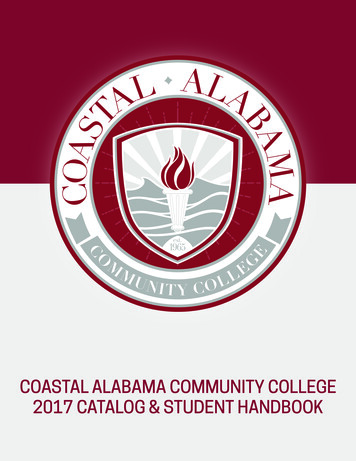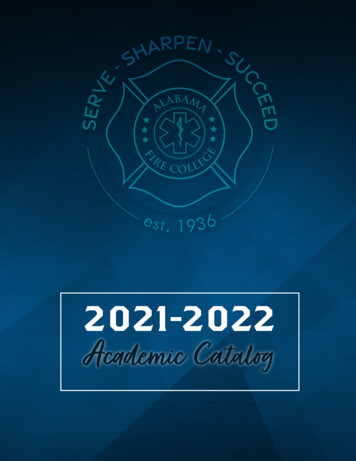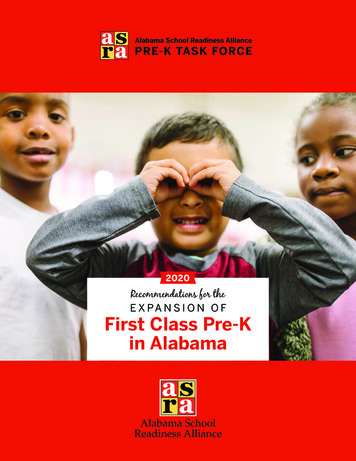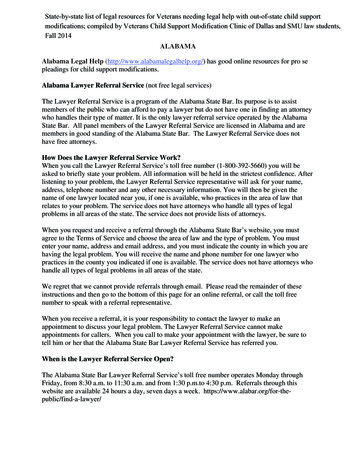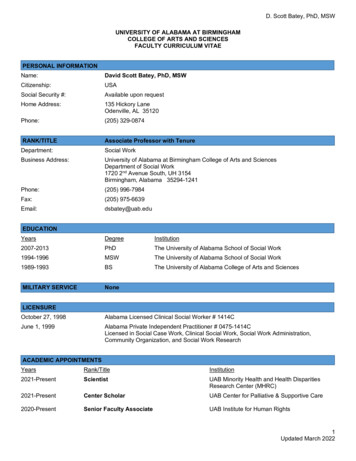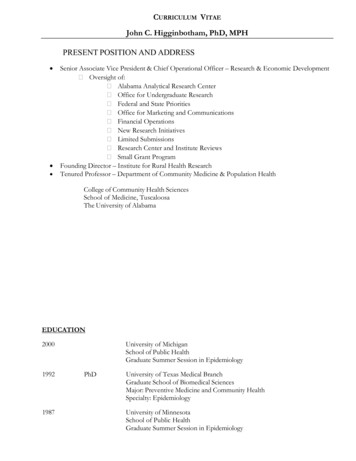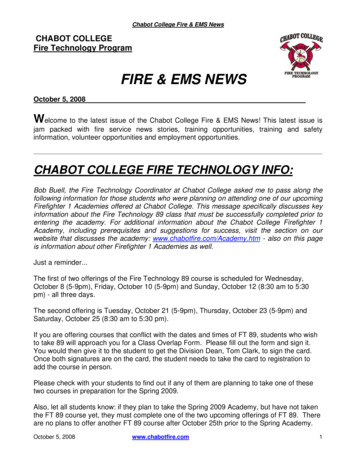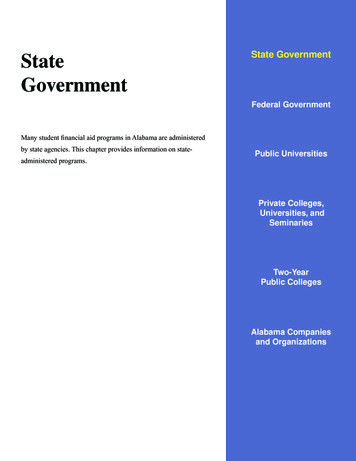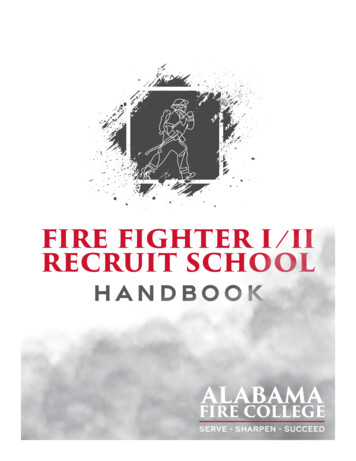
Transcription
fire fighter i iirecruit schoolhandbook
IntroductionOur aim in producing this handbook was to create a single document where you would be able toaccess the information you are likely to need to conduct a Firefighter I/II Recruit School under theauspices of the Alabama Fire College. This Handbook and corresponding policy documents form partof your contract with the Alabama Fire College to enable you to conduct recruit training.This document provides an overview of the processes for delivering recruit training and outlines whatyou can expect from us as the accrediting agency. In return, we ask for a high degree of commitmentand dedication while helping us achieve the goals and objectives of the Alabama Fire College.I hope you find this to be a useful resource in conducting your recruit training. The most up todate information will be available on our website. However, if you are unable to find the answer toyour question here, please feel free to contact me or a member of the Fire Programs staff who willcertainly be able to find an answer for you.Jason JacksonProgram Manager – Fire Fighter I/II
TABLE OF CONTENTS1 Course Overview16 Certification and Testing Process1 Course Syllabus16 Safety & Health Requirements3 NFPA 1001 Requirements (Firefighter I)17 Skills (JPR) Testing3 NFPA 1001 Requirements (Firefighter II)3 Administrative Code of Alabama19 Skills Evaluator Selection Criteria19 Skills Testing Orientation – Evaluators3 Chapter 360-X-1: General Regulationsand Administrative Procedures20 Skills Testing Orientation – Candidates4 Chapter 360-X-2-.02: Requirements forCertified Firefighter20 Skill Selection for JPR Testing5 Application Process to Conduct Training5 Approval of Training Site5 Course Application6 Student Registration Requirements7 Instructional Staff7 Course Coordinator7 Lead Instructor7 Assistant Instructor8 Curriculum Requirements8 IFSTA’s 7th Edition Essentials of Firefighting8 AFC Online:8 Attendance Module9 End of Chapter Testing10 Use of Submission Boxes11 Add Files13 Certification and Testing Requirements14 IFSAC/ProBoard Accreditation14 ADA14 Appeals/Rescore14 Audit14 Certification14 Course Prerequisites14 Privacy/Confidentiality14 Recertification14 Reciprocity15 Retest Policy15 Skills Examinations (JPR testing)15 Standard of Training-NFPA15 Test Administration15 Test Eligibility15 Preparation15 Test Scores15 Written Examination20 Skills Testing Safety21 Skills Evaluator Duties21 Proctor/Evaluator Discipline22 Skills (JPR) Test Day Outline23 Facilities & Equipment Requirements24 AFC Policies and Procedures24 Checklist for Training Facility27 Training Template27 Training Schedule28 Air Consumption Course28 AFC Campus Course29 Reference Material: NFPA 1001, 2019 Edition32 AFC Campus Evolutions34 SCBA Week Evolutions Schedule35 Live Fire Training for Recruit Schools:35 Evolution Checklist38 Recruit School Guidelines39 Recruit Grooming Standards40 Health Questionnaire Form41 Injury and Illness Reporting42 Late to Work / Tardy Form43 Withdrawal Form44 Physical Training Rehab Guidelines46 Rehabilitation Form47 Vitals Record Form48 Hydration Guidelines49 Outdoor Training Activities During ExtremeWeather Conditions Guidelines49 Extreme Heat50 Extreme Cold50 Other Conditions51 Graduation Procedures51 Graduation Information & Sheet53 Guest Speaker Information54 Fire Fighter Oath
COURSE SYLLABUSFire Fighter I/IIThis course consists of Fire Fighter I/II, HazMat/WMD A&Oand Rapid Intervention Crews (RIC).FSC 102360 clock hoursPREREQUISITES Entrance requirements set out in NFPA 1001: Standard for Fire Fighter Professional Qualifications18 years of ageHigh School Diploma/GEDPhysical Statement AFC and PSC Form 05Successful completion of Candidate Physical Ability Test (CPAT) within 12 months of start datePrior to Certification as a Fire Fighter I and II: (Pro Board or IFSAC) Certified Hazardous Materials/WMD Awareness and OperationsREQUIRED COURSE MATERIALSo Essentials of Fire Fighting and Fire Department Operations, IFSTA, 7th Editiono AFC Awareness Student Manualo AFC Operations Student Manualo 2016 Emergency Response Guidebooko FEMA Emergency Response to Terrorism Job Aid- Edition 2.0o Rapid Intervention CrewOther Required Equipment:o NFPA Compliant turnout gear and SCBA with spare bottleo PASS deviceo Approved Departmental or Fire College PT clothing (Fire College clothing is available at the AFC Bookstore.More than one PT outfit recommended.)o Running shoes are requiredDESCRIPTIONThis course is based on NFPA 1001, Standard for Fire Fighter Professional Qualifications. The course is designed for the person whoseeks the knowledge and skills to function as an integral member of a firefighting team under direct or general supervision inhazardous conditions. The Fire Fighter I/II course consists of a combination of classroom study, drill field practice, and trainingevolutions that will prepare the fire fighter to perform most fire ground functions under the supervision of an officer or experiencedfirefighter. Campus Delivery Only classes are delivered either at the Alabama Fire College (AFC), a Regional Training Center, or otherareas as approved by the Regional Coordinator and Training Staff at AFC.STUDENT LEARNING OBJECTIVES Initiate the response to a reported emergencyReceive a business or personal telephone callTransmit and receive messages via the fire department radioUse SCBA during emergency operationsRespond on apparatus to an emergency sceneOperate in established work areas at emergency scenesForce entry into a structureExit a hazardous area as a teamMarch 2020 Page 1 of 2
Set up ground laddersAttack a passenger vehicle fire operating as a member of a teamExtinguish fires in exterior Class A materialsConduct a search and rescue, in a structure, operating as a member of a teamAttack an interior structure fire operating as a member of a teamPerform horizontal ventilation, on a structure, operating as part of a teamPerform vertical ventilation, on a structure, as part of a teamOverhaul a fire sceneConserve property as a member of a teamConnect a fire department pumper to a water supply as a member of a teamExtinguish incipient Class A, Class B, and Class C firesIlluminate the emergency sceneTurn off building utilitiesCombat a ground cover fire operating as a member of a teamPerform a fire safety survey in a private dwellingPresent fire safety information to station visitors or small groupsClean and check ladders, ventilation equipment, self-contained breathing apparatus (SCBA), ropes, salvageequipment, and hand toolsClean, inspect, and return fire hose to serviceComplete a basic incident reportActivate an emergency call for assistanceExtinguish an ignitable liquid fire operating as a member of a teamCoordinate an interior attack line, for team’s accomplishment of an assignment, in a structure fireControl a flammable gas cylinder fire operating as a member or a teamProtect evidence of fire cause and originExtricate a victim entrapped in a motor vehicle as part of a teamAssist rescue operation teamsPrepare a pre-incident surveyMaintain power plants, power tools, and lighting equipmentPerform an annual service test on fire hoseTest the operability of and flow from fire hydrantCERTIFICATION REQUIREMENTSTo be issued certification, the candidate will: provide documentation of prerequisites, complete required training hours includingskills training, successfully complete the cognitive written exam, and successfully complete the practical exam.ACCREDITATIONAlabama Fire College and Personnel Standards Commission maintains accreditation with Pro Board and IFSAC. Each student willautomatically receive national registration and certification upon successful completion of all requirements for certification.COURSE SCHEDULE (SUBJECT TO CHANGE)Day One:See Appendix of the Instructor Manual for daily schedule; available to student on the firstday of class.GRADE ASSESSMENTWRITTEN EXAMINATIONPerform to a minimum 70% competency on the examination.(One retest is allowed after 30 days but within one year of course end date.)PRACTICAL EXAMINATIONSuccessfully complete a skills/project evaluation to a minimum of 70% competency and successful completion of all critical points.Evaluators will test at least 25% of the skills for each. Skill sheets to be tested will be randomly selected by AFC Certification Unit forthe practical examination. (One retest is allowed after 30 days but within one year of course end date.)March 2020 Page 2 of 2
NFPA 1001 Requirements (Fire fighter I)4.1 General. For qualification at Level 1, the fire fighter candidate shall meet the general knowledge requirements in4.1.1, the general skill requirements in 4.1.2 the JPRs defined in Sections 4.2 through 4.5 of this standard, knowledgeof the incident management system, and the requirements defined in Chapter 5 as well as mission-specificcompetencies in Section 6.2, Personal Protective Equipment, and Section 6.6 Product Control, of NFPA 1072.4.1.1 General Knowledge Requirements. The organization of the fire department; the role of the Fire Fighter I in theorganization; the mission of fire service; the fire department’s standard operation procedures (SOPs) and rulesand regulations as they apply to the Fire Fighter I; the value of fire and life safety initiatives in support of the firedepartment mission and to reduce fire fighter line-of-duty injuries and fatalities; the role of other agencies asthey relate to the fire department; the signs and symptoms of behavioral and emotional distress; aspects of thefire department’s member assistance program; the importance of physical fitness and a healthy lifestyle to theperformance of the duties of a fire fighter; the critical aspects of NFPA 1500.4.1.2 General Skill Requirements. The ability to don personal protective clothing, doff personal protective clothing,perform field reduction of contaminants and prepare for reuse, hoist tools, and equipment using ropes and thecorrect knot, and locate information in departmental documents and standard or code materials.NFPA 1001 Requirements (Fire fighter II)5.1 General. For qualification at Level II, the Fire Fighter II shall meet the general knowledge requirements in 5.1.1, thegeneral skill requirements in 5.1.2, the JPRs defined in Sections 5.2 through 5.5 of this standard, the requirementsdefined in Chapter 4, and knowledge of the Incident Management System sections of ICS 200 as described.5.1.1 General Knowledge Requirements. Responsibilities of the Fire Fighter II in assuming and transferring commandwithin an incident management system, performing assigned duties in conformance with applicable NFPA and othersafety regulations and AHJ procedures, and the role of a Fire Fighter II with the organization.5.1.2 General Skill Requirements. The ability to determine the need for command, organize and coordinate an incidentmanagement system until command is transferred, and function within an assigned role in an incident managementsystem.Administrative Code of Alabamai. Chapter 360-X-1 General Regulations and Administrative Procedures(8) Specification for approved training for certification.(a) To be recognized for certification by the Commission, training shall be obtained under the followingconditions:1. All certification courses must have prior approval by the Commission. Those agencies desiring to have acourse taught must submit AFC & PSC Form-09 entitled “Application for Course Approval” completed withall the required information.2. All certification courses must be taught using the current course curriculum approved by the Commission.3. All certification courses must be taught by an instructor certified to the appropriate level or otherwisequalified by his or her education and experience to a level demonstrating particular subject matterexpertise.4. All certification courses must be taught at a facility appropriate to promote a learning environment andable to safely and comfortably accommodate the number of students involved in the course. Certaincertification courses have more particular facility requirements as set out in the provisions below.5. All certification courses must have a sufficient number of students to facilitate the instructional processand ensure the safety of the student involved in the course. Certain certification courses have moreparticular requirements regarding the number of students as set out in the provisions below.6. The instructor will request that the state certification written examination be scheduled at the completionof the required training.7. Attendance of certification courses taught at locations other than the Alabama Fire College shall berestricted to members of Alabama state, county, and municipal agencies, except where courses areestablished through the AFC Industrial or DoD Programs Division or by an articulation agreement with apostsecondary institution.
(9) Specification for approval as a fire training center.(a) Any agency may, upon submitting AFC & PSC Form-08 “Inventory and Application for Approval as a FireTraining Center” to the Commission, be approved as a permanent Fire Training Center.(b) An approved permanent Fire Training Center must undergo re-evaluation and approval at a minimum offive-year intervals. Such re-evaluation may also be required at the discretion of the Commission prior to theapproval of any course as required in Section 8 above.ii. Chapter 360-X-2-.02 Requirements for Certified Fire Fighter(1) Requirements(a) Fire Fighter I certification courses may only be conducted at a permanent Fire Training Center approved bythe Commission.(b) This course has a minimum initial enrollment of eight (8) candidates.(c) Prior to entering the certification course, the candidate shall meet the Entrance Requirements set out inNFPA 1001, Standard for Fire Fighter Professional Qualifications, as adopted be the Commission.(d) Prior to certification, the candidate shall meet the general knowledge, skill, performance and additionalrequirements for Fire Fighter I as set out in NFPA 1001 Standard for Fire Fighter Professional Qualifications,as adopted by the Commission.(e) The candidate must have a high school diploma or GED.(f) The candidate must meet the requirements for certification prior to permanent employment or a period notexceeding 12 months after the date of employment at an approved training center.(g) Minimum age requirement is 18 years.(h) Prior to certification, the candidate shall be a Certified Hazardous Materials First Responder: Awareness andOperations. Training hours required for this certification may be included in the Fire Fighter I/II curriculum.(i) Prior to entering the certification course, the candidate shall provide proof of successful completion of acourse of first aid instruction equivalent to or exceed the requirements of NFPA 1001, current editions.(j) A minimum number of training hours.1. A candidate for this level of certification shall have completed 360 hours of training, excluding any hoursof training in emergency medical services, the format, and curriculum of which shall be approved by theCommission.2. The Fire Fighter I/II certification course shall be conducted in an academy format and according to aschedule that is approved by the Commission and which shall include the following elements:(a) Instruction and evaluation shall occur in a group setting with at least the required minimum number ofstudents as prescribed in this chapter.(b) The course shall be completed within a twelve month time period.(c) Instruction shall predominantly be provided to candidates’ in-person. Self-paced, correspondence, orpredominantly distance-delivery instruction is not permitted. In all cases, an approved instructor shallbe physically present and responsible for the course.(d) Skills evaluation shall be conducted in-person and under the supervision of approved test proctors.(e) During periods of instruction or evaluation, candidates shall be engaged solely in the educationalprocess and shall not be subject to emergency response, administrative, maintenance, or other tasksor duties not related to the course.
Application Process to Conduct TrainingApproval of Training SiteThe checklist for training facilities included in this handbook should be used as a guide in providing the necessarylogistical support required for the facility to be eligible to host a recruit school. It provides detailed informationregarding classroom, drill field, and equipment requirements. Any planned use of training props located off-sitemust be documented and approved by the Alabama Fire College (AFC) prior to granting approval to host the class.This checklist will be used by AFC when conducting a site visit prior to any approval and subsequently thereafter on a5-year cycle or at the discretion of the Alabama Fire College.Course ApplicationAFC is continually seeking to improve our operations and processes. A part of improvement involves our ability tocapture, synthesize, and process data. With the addition of regional training centers (RTCs), various course deliveryformats, and student and instructor access to online materials it was necessary to modify the course application(formerly called the ‘field course application’). These changes will result in a reduction in delays for the end usersbecause the correct information will be captured beginning with a course request.The course application should be used to apply for department delivery and RTC courses. This form is available online.RTCs should complete the course application as well as the training site approval checklist. When applying for FireFighter I/II, please indicate the dates of the co-requisite courses as well. Course applications for Recruit School/Bridgeprograms should be forwarded to Jason Jackson.1.Indicate whether the course is being held at a RTC or local fire department.2.The hosting department/agency is the location of the department or agency where the course is beingconducted.3.The training location address must be completed in full and indicates the actual physical location where thetraining is being held.4.The course coordinator is the person who completed the course application and with whom AFC personnelwould interact. This is the person who should have all the course details.Course dates: AFC is aware of the many different schedules that our constituents work. As such, we encouragedepartments to offer courses that will allow as many to attend as possible. This means offering courses onalternative schedules including shift based, nights, and weekends.5.The course format indicates the course delivery method. A detailed description of the course delivery methodsand associated courses can be found online.6.Marking “AFC Online access” prompts AFC staff to place students and instructors with valid email addressesinto the AFC Online platform so that they can access the instructional materials, quizzes, etc. through theinternet. Having student and instructor information two weeks in advance of a course start date assistsCertification, Curriculum, and IT to ensure that instructors have access to the most current curriculum availableand students have access to course materials when the course begins.7.The last 4 digits of SSN are needed to verify that the instructor and JPR/skills proctor/evaluator have thecredentials to evaluate the students. In other words, the instructor and proctor are certified in the subjectmatter, they are teaching and have Fire Instructor I (or equivalent) at a minimum. Remember that neitherProBoard nor IFSAC allows anyone who has instructed a subject area or topic in a course to evaluate the skills/projects for that same subject/topic.8.Participant Information:a.Seats available-the total student capacity for the courseb. Reserved seating-the number of seats a department wishes to reserve for their or other personnelc.If a department foresees that they will not be able to fill the number of reserved seats they originallyanticipated, please contact your regional coordinator so he can decrease the number of reserved seatsand increase the number of open registrations to maximize the number of students who have access to thetraining.Open registrations-the number of seats offered by the host agency for outside students
9.Indicating the Requested Cognitive Certification Test Type will assist Certification and IT in ensuring that theexamination materials are prepared for distribution in a timely fashion. There are approximately twentycertification courses each week throughout the state. Test materials, whether online or hard copies, have to beprepared so that tests can be administered at the end of each course. Preparation of testing materials requiressignificant time and effort on the part of Certification and IT.Student Registration RequirementsPlease have students write legibly or have them type information into the registration form and print it out. Studentscannot be registered without payment. All documents must be submitted at the time of registration.1.Only Alabama personnel can attend department-deliverable Fire Fighter I/II courses. Course coordinatorsshould print a new Fire Fighter I/II Recruit School application for each course from the website.2.The FF I/II application has a list of all minimum pre-requisites and admissions criteria.3.All admission documents must be submitted three weeks prior to the begin date of course.Registration RTC Delivery:The RTC course coordinator is to have students call 1(800)241-2467 and ask for Student Services for guidance in theadmission process. It is the RTC course coordinator’s responsibility to send applications and all admissions criteria fortheir personnel to Student Services.Please send to:Postal: Alabama Fire College, Student Services, 2501 Phoenix Drive, Tuscaloosa, AL 35405Email: -7404
Instructional StaffThe instructional staff is one of the most vital parts of recruit training. Staff set the tone for the success or failureof the class. The instructors must be well versed in multiple teaching methodologies, and mentorship is stronglyencouraged. The instructional staff required to conduct recruit training will consist of a course coordinator, leadinstructor, and assistant instructors.Course CoordinatorThe Course Coordinator is the person who completed the course application and with whom AFC personnel wouldinteract most frequently. This is the person who should have all the course details. In addition, the course coordinatorshould be thoroughly familiar with the Recruit Handbook. Specifically, details related to AFC policies and procedures,AFC Online, the injury and medical forms, exposure reports, termination procedures, registration, certification, JPRtesting, the Recruit “Trainee” School agreement, and the training facility checklist, to name a few.Lead InstructorThe lead instructor is primarily responsible for ensuring that the academic knowledge and practical skills are deliveredin a positive, productive, and effective manner. The following credentials are needed to serve as a lead instructor forrecruit training: Fire Fighter I/II certification Fire Instructor II certification Three years as a certified Fire Fighter II NIMS 100, 200, 700, 800 HazMat Awareness & Operations certification Live Fire Instructor-in-Charge certification Rapid Intervention Crew certification FDSO: Incident Safety Officer certification Alabama Fire College Recruit Training update Alabama Fire College Cancer Awareness trainingAssistant InstructorThe Assistant Instructor assists in all facets of instruction for which he/she is qualified as well as logistical support forthe lead instructor. Fire Fighter I/II certification Fire Instructor I certification One year as a Fire Fighter I/II NIMS 100, 200, 700, 800 HazMat Awareness & Operations certification Alabama Fire College Recruit Training update Alabama Fire College Cancer Awareness training
Curriculum RequirementsIFSTA’s 7th edition Essentials of FirefightingThe curriculum used in all recruit courses is the 7th edition of IFSTA’s Essentials of Firefighting. This textbook isto be used in conjunction with AFC Online. The most up to date teaching outline, PowerPoint presentations, andsupplemental materials will always be found in AFC Online.AFC Online1.Attendance Module:Attendance sessions should be set up for your class. If they are not, please email tmcnair@alabamafirecollege.org.To take attendance, go to your course page and select the link labeled “attendance.”This will bring up the current week’s classes. Click on the green dot to the right of the date you are takingattendance. (Please note dates are in the European date format, so they are listed as dd.mm.yy).For each student, mark their attendance for:Present PAbsent ALate LExcused EWithdrawn WWhen attendance is complete, select “Save attendance.”
2.End of Chapter Testing:All end of chapter testing is done through Respondus Lockdown browser and must be proctored by the instructor.If you are testing in a computer lab or department issued computers, the lab version can be downloaded here:LockDown Browser: lab edition - Windows or MacIf they are testing on personal computers, they will be directed to the link if they attempt to open a test usinganother browser:End of subject exams are hidden from the student until it is time to take the test.To make the test visible, click the “Turn editing on” button in the top right-hand corner of the course screen:Items that are in gray are visible to the instructor, but not to the students.Scroll down to the exam you wish to give and select Edit Show.Once testing is complete, the test must be hidden again.
3.Use of Submission Boxes:When asked to submit documents, select the link labeled “submit.”Select “Add submission.”From this page, you have two options for loading files.You can select the paper icon at the top left of the screen, or you can “drag and drop” your files:
4. Add Files:If you choose to add files, select the papericon. When the form comes up, make sure on the left it says“upload a file” and then select the “choose File” button. Find your file in the window, select and then select the“open” button. Find your file in the window, select, and then select the “open” button. When the file managerwindow closes, the “upload this file” button must be chosen.Your file will now appear in your file submissions box. Select save changes.
Drag and Drop Submission: To “drag and drop” a file, open your computer folders. Find the file you want to upload.Select the file. Hold the mouse button down, move the file to the window until you see a note below the filelabeled “move.” Let go of the button.Your file will now appear in your file submissions box. Select “save changes.”
Certification and Testing RequirementsPlease direct inquiries to the Certification Division at certification@alabamafirecollege.org. Accreditation ADA Appeals/Rescore Audit Certification Course Prerequisites Privacy/Confidentiality Recertification Reciprocity Retest Policy Skills Examination (JPR Testing) Standard of Training (NFPA) Test Administration Test Development, Security & Analysis Test Eligibility Test Preparation Test Scores Written ExaminationPolicies: Certification & Testing Process Facilities & Equipment Requirements, Admin Code 360-X-1 – Specifications for approval as a fire training center Safety & Health Requirements Skills (JPR) Testing Skills Evaluator Selection Criteria Skills Testing Orientation – Evaluators Skills Testing Orientation – Candidates Skills Testing Safety Skill Selection for JPR Testing Skill Evaluator Duties Proctor/Evaluator Discipline Skills (JPR) Test Day Outline
IFSAC/ProBoard Accreditation:The accreditation of AFC’s certification processes by ProBoard and IFSAC assures complete compliance with theprocedures and criteria established by these accrediting entities. AFC is proud to act as a certifying agent undertheir sponsorship. Currently, AFC issues certification automatically and at no further charge for the individual uponsuccessful completion. Please visit the websites at www.TheProBoard.org (individually accessible certification look-up)and www.IFSAC.org for more information.ADA:Anyone needing special accommodations for certification programs and/or testing shall request such provision noless than thirty (30) days prior to the scheduled event. Requests must be submitted by the student along with theappropriate disability documentation on official letterhead and verified by an appropriate physician. Services andreasonable accommodations are provided pursuant to Section 504 of the Rehabilitation Act of 1973 and the Americanswith Disabilities Act of 1990.Appeals/Rescore:Students may request an appeal in writing within 30 days of the testing event (written or skills). As a result ofprocedures in place to score and verify scores, students are not encouraged to request hand-scored answer sheets, asthe equipment is checked for accuracy on a regular maintenance schedule.Audit:A student may choose to audit (no certification testing) a course at AFC and receive a certificate of attendance. Oncethe declaration for the audit has been filed and processed, the student will not be allowed to recant and test.Certification:Certification requirements for each certification course are any specified prerequisites and successful completionof the written and skills examinations as listed on the Certification Criteria for each course. All testing/certificationpaperwork must be completed and ALL required signatures, dates, hours, scores, topics, etc. received by the TestingDivision before certification can be awarded. Upon successful completion and receipt of the required paperwork, acertificate with the Alabama and applicable ProBoard seal and/or IFSAC seal will
5.1.2 General Skill Requirements. The ability to determine the need for command, organize and coordinate an incident management system until command is transferred, and function within an assigned role in an incident management system. Administrative Code of Alabama i. Chapter 360-X-1 General Regulations and Administrative Procedures
